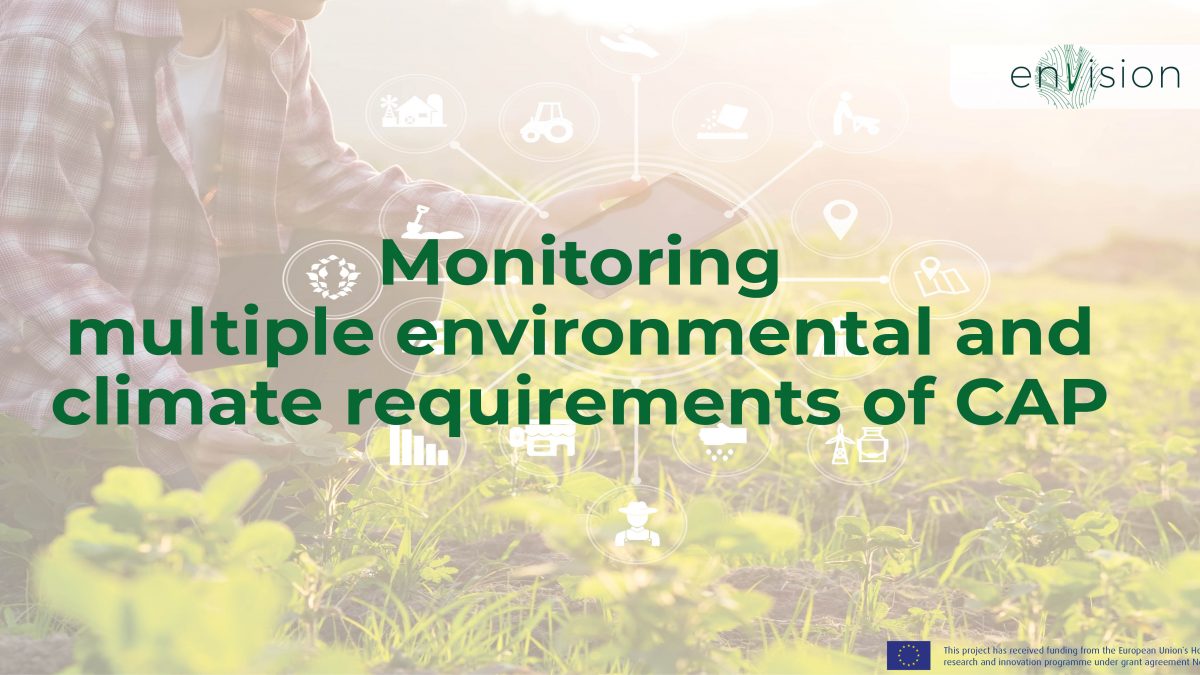ENVISION services supporting the business case of Lithuania and Cyprus are:
- Cultivated Crop Type Maps
The Cultivated Crop Type Maps (CCTM) is an Earth Observation (EO) crop classification module that exploits satellite data along with the usage of Machine Learning techniques in order to provide products related to the validation of the declared crop type by a farmer. In addition, it provides the knowledge of the compliance with certain environmental rules such as Greening requirements. Thus, it can be used from the Paying Agencies as a tool to enhance the process of checking the declarations of the farmers at the time of declarations, but also to assist via smart sampling of parcel to be checked during the validation process (OTSCs). This can be achieved as the service that informs the PAs about the parcels that have a high probability of being wrongly declared.
The Crop Diversification Service exploits the Land Parcel Information System (LPIS) and the declarations of the farmers. Thus, it will monitor crop types included in the aforementioned files and it will make a merge of crop types if the exhaustive process cannot distinguish between two or more of them. As a result, the predicted crop type of each declared parcel will be generated along with a percentage of prediction’s confidence and it will be used as indicator for the declaration process. Last but not least, taking into account last year’s farmers declarations, this service will be able to point out possible Land Use/Land Cover (LULC) changes, if they exist.
This service will deliver a number of EO derived products for cultivated crop type maps consisting of:
- Crop type maps
- Crop compliance with Greening-1 rule
- Alert mechanism for smart sampling
The service will make multiple classification of the crops throughout the year to ensure the confidence of the classification process. To ensure high accuracy, the system will utilize both Sentinel-1 and Sentinel-2 data.
- Analytics on Vegetation and Soil Index Time-series
The Analytics on Vegetation and Soil Index Time-series (AVSIT) is an Earth Observation (EO) monitoring module that exploits satellite data along with the usage of Machine Learning (T.B.D) algorithms on top of Datacube platform in order to provide into users’ realistic indications related to the field activities and the control of cross-compliance policies. More specifically, this module will take advantage of numerous potentials of Datacube introducing an innovative Big Data framework in the field of CAP monitoring from Paying Agencies (PAs).
Initial assessment and visualizations from the derived satellite signals can be performed in order to check the degree of compliance of agricultural parcels and the advisable cultivations periods of the respective Catch crops and Nitrogen Fixing crops, as well as the maintenance of no crops bare lands or spontaneous cultivated areas for the production of green manure such as black and green fallows respectively. Monitoring of activity in the above cases is considered as a necessity from the perspective of GAEC 4 and similar soil-erosion regulations, reinforcing EFA practices. Furthermore, CAP Cross Compliance conditions such SMR 1 and GAEC 1 are tackled by the proposal of a risk assessment for water pollution in the Nitrate Vulnerable Zones (NVZs). The risk assessment employs RUSLE products and the proximity to surface waters. The SAVI index is used for the identification of parcels with high soil coverage, providing a monitoring solution to the GAEC 4 conditions. Finally, Burnt Scar Mapping algorithms are developed to fit the ENVISION needs and specifically answer the GAEC 6 requirement. Last but not least, detection of activity inside Natura2000 regions will be a critical challenge remained to be solved since Sentinels spatial resolution as well as the scarcity of such events as ground truth poses significant deterrents on that venture.
This micro-service combines Sentinel-1 and fused Sentinel-2 data so to generate vegetation and soil indices at national scale. At a next level, the service aims to provide geospatial analysis. This analysis comprises of charts, statistics and data visualizations for understanding complex relationships, finding trends and reveal changes throughout the time. Moreover, it can help on predicting what is going to happen next by pattern recognition. Finally, several algorithms that will be implemented (ideally or modified) based on the legacy and the rich methodology of RECAP project that NOA developed, since similar problems tackled with success in the general goal of CAP monitoring.
Analytics on Vegetation and Soil Index Time-series (AVIST) aims at providing vegetation and soil indices, along with geospatial analytics such as growth trends, change detection, phenological metrics, soil specific indicators, static indicators with respect to rainfall erosivity and soil erodibility, cover management factor for soil erosion, Natura2000 areas hotspot detection, Burnt Scar Mapping and Runoff Risk assessment for the reduction of water pollution in Nitrate Vulnerable Areas. The final set of subservices remains to be defined after the processing of user requirements. Some and not all of the aforementioned services will be developed.
This micro-service will deliver a number of EO derived products for crop monitoring and data analytics consisting of:
- Vegetation status map and agricultural monitoring of Ecologically Focused Areas (EFA) practices such as Catch-Crops, Nitrogen-Fixing crops and Fallow lands.
- Runoff Risk assessment for the reduction of water pollution in Nitrate Vulnerable Areas.
- Buffer Strips for the Proximity to water-ways nearby.
- Minimum soil cover for Soil Erosion
- Automated Burnt Scar Mapping (BSM) for the maintenance of organic matter in soil and identification of stubbles burning.
- Natura2000 regions activity hotspot detection (clearing)
- Other GIS querying functionalities
The service will provide multiple Analytics reports throughout the year taking advantage of both Sentinel-1 and Sentinel-2 data available along with additional products generated from the raw data.
- Grassland Mowing Events Detection
The Grassland Mowing Events Detection micro-service is an Earth Observation (EO) change detection module that exploits satellite data along with the usage of Decision Trees enhanced with Machine Learning (ML) and Artificial Neural Networks (ANN) algorithms (TBD). Based on the reproduction (partially or entirely) and enhancement of other similar projects’ routines (e.g. SEN4CAP) pipelines, the main scope is to efficiently monitor grassland activity and precisely track the key dates of those cultivation events taking place. More specifically, it combines Sentinel-1 data (VV, VH and VV-VH ratio backscatter polarization coefficients and VV, VH coherences) and Sentinel-2 (fused if needed) NDVI time series, incorporating texture features such as homogeneity, entropy, contrast and dissimilarity (if needed), along with FAPAR, fCover and LAI indices and potentially VHR data (if needed), as provided by the PAs.
The product will be updated with every new image acquisition. Continuous change detection products will issue alerts for the detection of a cultivation event, such as mowing, and if it is possible discriminate those from grazing activity. Finally, the grassland events detection product will be provided dynamically accompanied with the respective confidence level, delivering updated versions to the user with every new acquisitions. The grassland mowing detection processing chain will be built on top of the Data Cube, allowing for its large scale and timely application.
Finally, this information can be used from the PAs and in parallel with the grassland regulations provided into the system encapsulating the maximum number of possible events and the exact period these can take place, this service will export an estimation regarding the compliancy from the farmers.
This service will provide a fully automated identification of Grassland Events module, with a view to assist in the valid and on-time identification of main events taking place in grasslands, such as mowing and grazing (if possible).
The service will contribute into the direct supervision of the Paying Agencies (PAs) of the compliancy of grasslands farmers to the respective regulation of pilot countries regulations and indication of possible declination from them. Given that, PAs will be able to organize and realize more accurate field visit campaigns to more specific locations pinpointed from that service and as a result will drive into the reduction of the inspections cost.
This service will take advantage of EO derived indicators of agriculture monitoring, assisting to track the aforementioned grassland events. These indicators will be constructed using the available Sentinel-1 and Sentinel-2 images.

